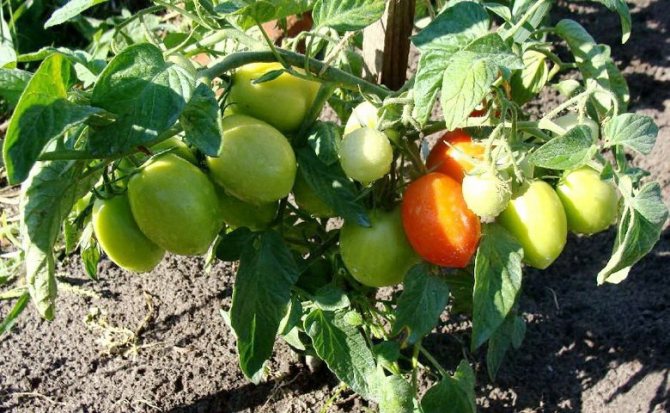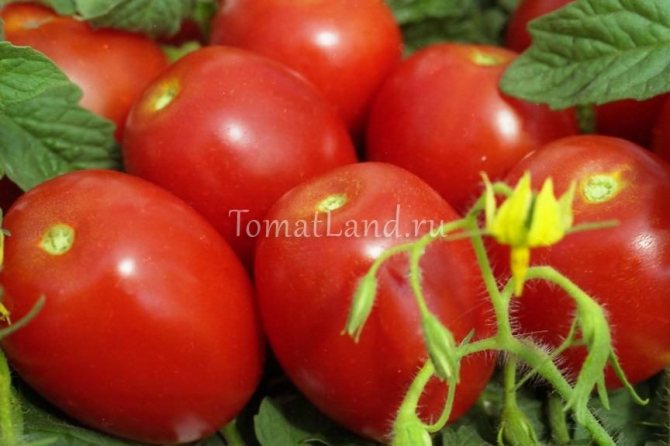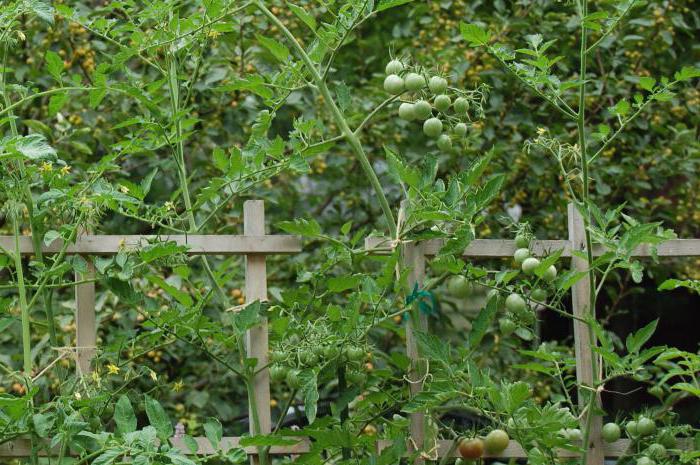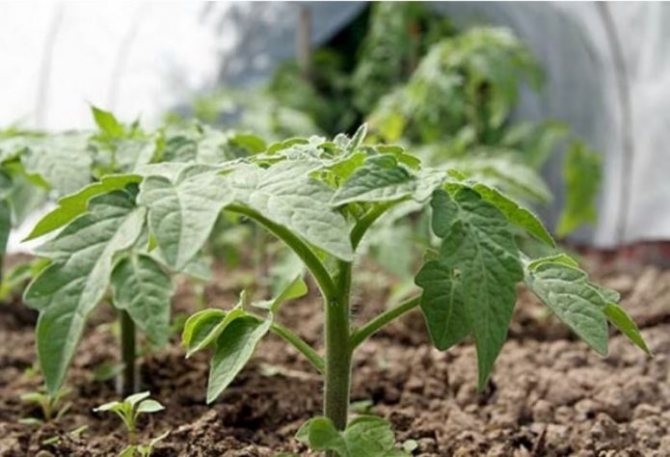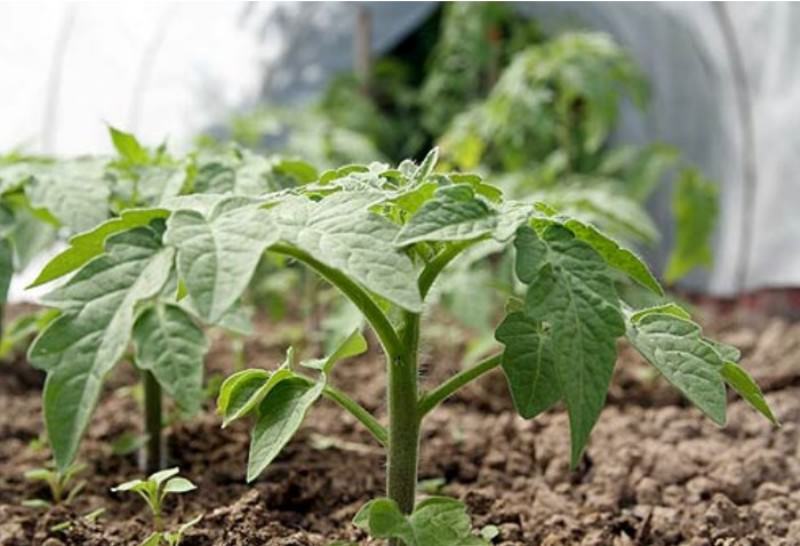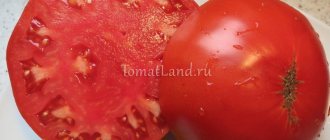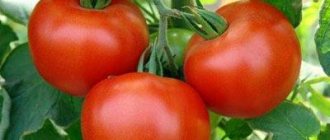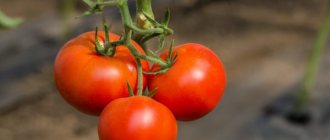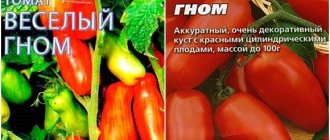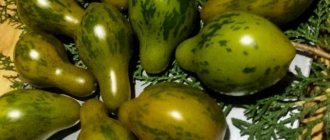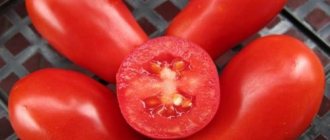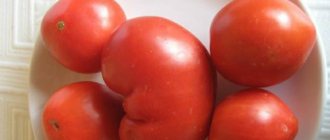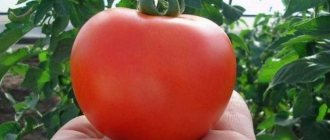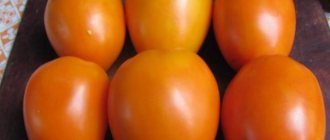For the mass cultivation of tomatoes in the open field, you need to select low, but high-yielding varieties that are very easy to care for. Breeders are always happy to help, so in the arsenal of every gardener there is sure to be a domestic variety that has been tested by more than one growing season. Among them is Valentina. Its applicant back in 1997 was the FGBUN Institute of General Genetics. N.I. Vavilov. In 1998, the novelty was entered into the State Register of Breeding Achievements of Russia with admission in all regions of the country. It is well known abroad, in Moldova and Ukraine this variety is also cultivated with pleasure. The tomato is recommended for growing outdoors in garden plots, in private and small farms. Not a hybrid.

Characteristics and description of the variety
The Valentine tomato variety was bred more than two decades ago by Russian breeders. Included in the State Register of Breeding Achievements in 1998. Ideal for cultivation in any climatic conditions of the regions of Russia, both in open and protected ground.
Distinctive features
Determinant type, non-standard, spreading, height 55-60 cm. Low branching, yellow-green leaves. The inflorescences are simple, the first is laid over 6-7 leaves, the subsequent ones every 1-2 leaves.
reference! The main difference between a non-standard plant and a standard plant is a weak stem.
An early ripe species, from the moment of emergence to full maturation, it takes 95-100 days.
The yield is high, 3-4 kg are harvested from 1 seedling, provided that 6-7 plants are planted per 1 sq. m. Fruiting is not stretched, ripening occurs at the same time.
Differs in high resistance to the main diseases of the Solanaceae family. Well adapted to short drought conditions.
The culture does not require pinching, but you cannot do without a garter, despite the short stature of the seedlings. The fruit-bearing branches are strewn with ripe vegetables, so they cannot bear the weight of their weight.
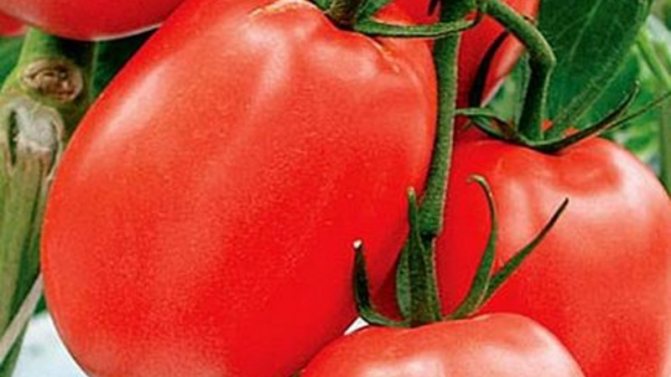

Fruit characteristics
Average weight 80-90 g, oval shape, elongated, orange-red color, intense. The taste is sweet with a slight sourness, the pulp is juicy, fleshy. There are 2 seed chambers, few seeds. The skin is thick, firm, not prone to cracking.
The purpose of tomatoes is universal: they are used fresh for the preparation of various dishes, they are used for winter harvesting and are put into processing for tomato products.
Ripe vegetables can be stored for several months and can withstand long transportation without losing their presentation.
The photo shows Valentine tomatoes.


How to grow seedlings
Sowing seeds for seedlings begins 2 months before planting in the ground. The seed must be prepared for planting in order to prevent a number of diseases and increase the quantitative indicator of fruiting.
Seed preparation
The beans are laid out on the table and carefully examined one at a time for visible damage. Grains suitable for sowing must be light in color, free from distortions and defects. Then they are placed in saline solution for 10 minutes. Those seeds that have sunk to the bottom are washed with running water and disinfected in a weak solution of potassium permanganate for 20 minutes.
To improve germination, the seeds are soaked in a growth stimulator for 10 hours.Swollen grains can be sown in the ground.
reference! In addition to specialized preparations, melt or ordinary boiled water can serve as a growth stimulant.
Capacity and soil
The soil is prepared from a mixture of garden soil, humus, peat and river sand. River sand is added as a baking powder for ease... Peat contains many nutrients necessary for the full growth and development of seedlings. Such a nutritious and fertile soil will speed up the emergence of seedlings.
The resulting mixture is disinfected by steaming in an oven at a temperature of 50 ° C for at least 15 minutes or spilled with a hot manganese solution. Disinfection of the soil destroys pathogenic flora, which leads to healthy growth of seedlings throughout the entire period.
You can plant in a common wooden box and in a separate container. The prepared soil is filled with the planting container in half, adding the remaining soil as the seedlings grow. This technique helps to constantly receive the required amount of nutrients. At the bottom of the containers, small drainage holes are made in advance to drain excess moisture into them.
Sowing
Seeds are sown to a depth of 1.5-2 cm with a distance of 3 cm from each other. Fall asleep from above with earth, level, compact and slightly moisten with warm, settled water using a spray bottle. The seeded containers are covered with foil, thereby creating a greenhouse effect and left in a dark and warm room at a temperature of 24-26 ° C until shoots appear.
Growing and care


When seedlings appear, the film is removed, and the containers are rearranged in a well-lit place on the windowsill. The temperature regime is kept at around 24-25 ° C. Daylight hours for seedlings are at least 14 hours. If the plants do not have enough daylight, they are supplemented with phytolamps.
Watered moderately along the edge of the nursery with warm, settled water with an ordinary tablespoon. The main thing is not to flood the sprouts, as excess moisture will negatively affect the young roots. After watering, the soil is superficially loosened with a wooden stick.
When 2 true leaves appear, the seedlings dive, seating them in separate containers. If the seeds were sown in peat pots, the seedlings do not need picking. The picking procedure involves shortening the main root by one third. The picking contributes to the growth of lateral roots, due to which the seedlings grow vigorously.
reference! Throughout the entire period, seedlings do not need feeding.
2-2.5 weeks before planting, the seedlings are hardened by taking them outside for 1 hour at a temperature of 16 ° C. The time spent outdoors is gradually increased to 14 hours. Simultaneously with the daytime hardening, the nighttime room temperature is reduced to 12 ° C.
Growing tomatoes
Variety "Valentina" is grown using seedlings.
How do I prepare the seeds?
IMPORTANT: Fresh aloe juice is a natural remedy that ensures good germination of seeds.
Before planting, it is very important to select whole and dense seeds that are not damaged by fungi or insects. Many vegetable growers disinfect seed in a pinkish solution of potassium permanganate. Also, the best germination of seeds will be provided by soaking for several hours in special growth stimulants.
Sowing seed
To plant seeds, it is necessary to prepare a nutritious soil consisting of garden soil and humus. In a container with soil, seeds are planted to a depth of 1.5 to 2 cm. The soil is sprayed with warm water, covered with plastic wrap. Boxes with future seedlings should be in a warm place.
After the emergence of shoots, the shelter is removed. Seedlings should be in a well-lit room - in this case, they will grow better.
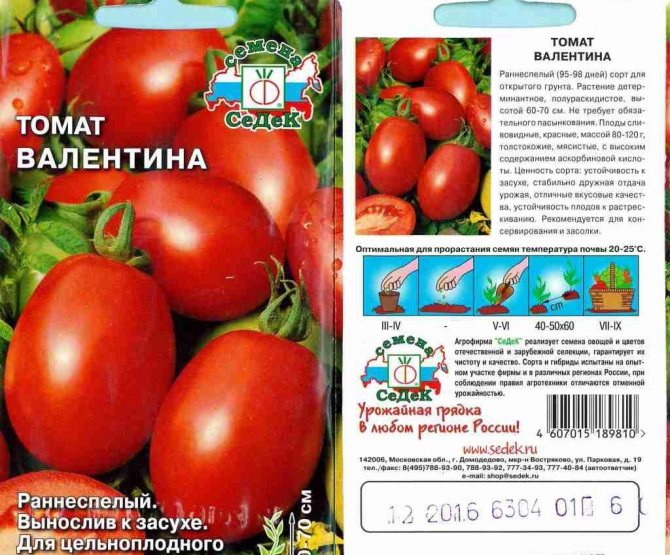

After the appearance of several true leaves, the plants are picked into separate cups or pots.
Before planting bushes in a permanent place of growth, they should be fed with nutritious mineral complexes.
Seedling planting rules
Plants are planted in open ground in early summer, in a greenhouse earlier - around mid-May. Seedlings are placed in pre-prepared holes, at the bottom of which there is sifted wood ash or superphosphate. For 1 sq. no more than 6-7 plants are placed per meter.
After planting, the seedlings are watered with warm, settled water. After a few days, the plants are fed with complex mineral fertilizers.
How to grow tomatoes
After 2 months, the seedlings are ready for planting in the ground. By this time, it has 5-7 true leaves, a strong stem and a fully developed root system.
Landing
The soil is prepared in autumn, dug up and fertilized with humus. In the spring, they dig it up again with the introduction of mineral fertilizers. For planting, holes are prepared with a depth of 15-20 cm at the bottom of which a little sawdust or wood ash is placed.
Transplanted on a cloudy day or in the evening, after sunset. The tomato is planted in the ground in which beets, herbs, garlic, cabbage or carrots previously grew. After these crops, the soil is not depleted, which is favorable for crops from the Solanaceae family.
Planting pattern: 40 cm - distance between seedlings, 60 cm - distance between rows. For 1 sq. m place 6 - 7 plants. They are planted in a checkerboard pattern, which helps to ventilate each plant and obtain the required amount of light. After transplanting, the bushes are not watered or fed for 2 weeks. During this time, they adapt to new conditions.
Further care of the Valentine tomato
Regular watering is set no more than 2 times a week. Watered with warm water, spending 4-5 liters under each bush. During the formation of buds, the number of waterings is increased, watering every 3 days. After each watering, the beds are loosened, removing weeds and thereby destroying a favorable substrate for the development of fungal diseases.
Also, pests reproduce successfully in weeds, which, switching to tomatoes, destroy both the leaves and the fruits themselves. To keep the beds moist longer, they are mulched with peat or straw.
Tomatoes are fed once every 3 weeks. Before flowering, fertilizers are used as top dressing, containing mainly nitrogen, which is needed for the active growth of shoots. Organics are also used, for example, a urea solution.
During the formation of the ovaries, they are fed with potassium-phosphorus fertilizers for faster pouring of the fruits. 35 g of superphosphate and potassium salts are dissolved in 10 l of water.
reference! All dressings are applied after watering, under the root of the plants.
Features in care and possible difficulties
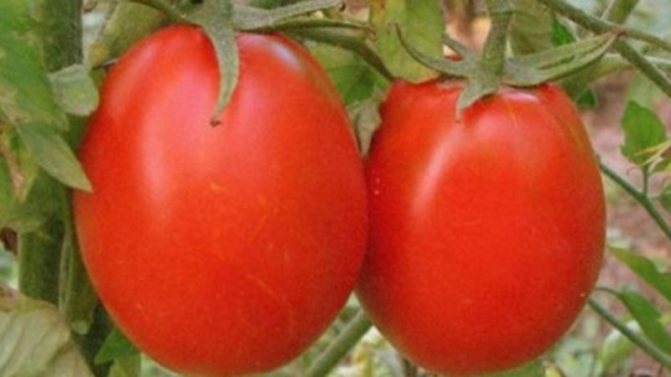

Culture does not require pinching. Moreover, experienced gardeners claim that pinching this variety leads to a decrease in yield.
Bushes need a mandatory garter not only of the stem, but also of the fruit-bearing branches. To do this, next to each seedling, wooden stakes or metal rods are installed, to which the plants are fixed. If the stem is tied to a support immediately after transplanting, the stem will form even and strong. As the branches develop, they are also necessarily fixed, otherwise they will creep along the ground from the weight of ripe vegetables. In addition, the tied branches make harvesting easier.
Diseases and pests
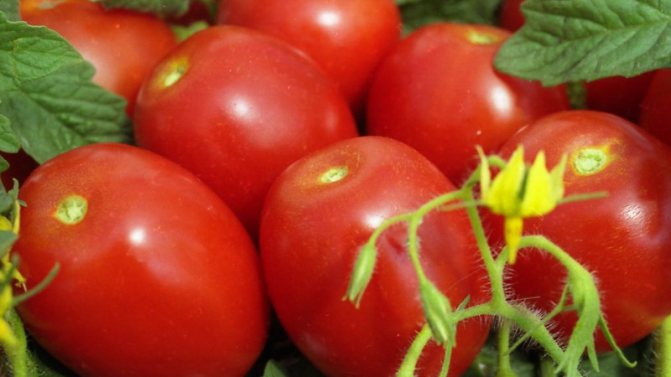

The most dangerous for tomato are fungal diseases such as late blight, gray rot and fusarium leaf wilting. The risk of diseases increases with prolonged rains and constant humidity in the beds due to non-observance of a moderate irrigation regime.
For prophylactic purposes, the plants are treated with contact fungicides "Fitosporin" and "Hom".You can also spray plants with infusions of various herbs, for example: nettle, plantain, onion peel decoction.
Processing plants with such infusions protects the culture from many pests that do not like pungent odors. These include: whitefly, spider mite, bear. To scare away a bear living underground, chopped cloves of garlic are dug into the beds.
The surest preventive method is to examine the bushes for pests and changes. Thus, pathology can be prevented almost immediately, which will preserve plant health.
Plant care
For tomatoes to develop well, they need:
- watering;
- loosen the soil;
- tie to a support;
- weed;
- inspect for rot and disease;
- harvest on time.
The characteristics and description of the variety say that it is resistant to droughts and cold snaps. For the fruits to ripen, the bushes need to be watered. The procedure is carried out in wet weather twice a week, in dry weather - once every two days or every day.
Weeding is carried out as the weed grows, after each watering, the soil is loosened. Fertilize the bushes and the soil under them at least three times per season. To do this, use mineral fertilizers, complex or one-component and organic: cow or chicken droppings, compost infusion, humus.
Tomatoes need to be harvested on time so that the green fruits have time to ripen. If ripe fruits hang on the bush for a long time, then new vegetables will not form. If these conditions are met, beautiful plum tomatoes will flaunt on your table until late autumn.
The nuances of cultivation in the open field and in the greenhouse
Tomato leaves have a yellow-green color, but this does not mean that the plant is unhealthy. This color is quite normal for this variety and does not imply any remedial measures.
Pinching the shoots leads to a decrease in the quantitative indicator of fruiting; it is not recommended to pick off the leaves even during the seedling period. The only leaves that need to be removed are the lowest ones, as they can rot and cause various infections on contact with wet beds.
When transplanting into open ground in regions with a temperate climate, do not forget about the danger of an unexpected drop in temperature. For such cases, a covering material is kept at hand in order to use it immediately if necessary, thereby preserving the plants. Also, the culture is sheltered in case of prolonged rains.
Closed structures are ventilated on a daily basis. The influx of fresh air destroys the habitual habitat of pathogenic microorganisms and many pests. In addition, ventilation regulates the state of humidity, preventing it from rising and creating favorable conditions for the development of diseases.
More about leaving
The description of the "Valentine" tomato and the captions under the photo show that special care is not required for this variety, however, tomatoes do not grow like weeds. Elementary care for them is still necessary. Yes, this species does not require the creation of special soil or special conditions for ripening and increasing yields. At the same time, professionals talk about the need to follow a few simple rules:
- Ensuring proper watering. This does not mean that you should pour tomato seedlings with water every day. Either a little every day, or once a week and very abundantly.
- Regular loosening of the earth. You can also loosen the soil around the sprout once a week.
- Frequent cleansing of the land next to seedlings from weeds. Weeds not only take water from the ground from the tomato, but also the nutrients that are necessary for their proper and timely development.
- Spraying against insect pests. This variety is protected from common diseases, but it is not protected from insects that eat its foliage, flowers and roots.
- In a greenhouse, it is important to provide the plant with frequent ventilation. Once a day is enough.
- If the seedlings are planted in open ground, at first it will need to be covered with a film.
A warning! Watering plants should be done only with warm water, in no case cold.
Moreover, the water must be settled. That is why experienced gardeners have large containers on their plots in which they store water for irrigation.
Those who have been growing Valentina tomatoes for more than one year willingly post a description of this variety and a photo of their own harvest precisely because they have something to boast about. Beautiful appearance, amazing taste and unforgettable aroma are its main advantages.
Harvesting and application of the crop
Ripe vegetables are harvested in July-August. Fruiting is not stretched, ripening is almost simultaneous, which greatly simplifies collection.
The purpose is universal: smaller tomatoes are used for whole-fruit canning, barrel pickles and pickles. Larger vegetables are used for processing into tomato products, from which excellent juices, pasta, adjika, ketchup and lecho are obtained.
Also, tomatoes are ideal in any fresh dishes: summer salads, hot and vegetable stews, mashed potatoes, they are used in a variety of snacks, for sandwiches. Also used in baking with meat and for pizza.
Ripe vegetables can be stored for several weeks or even months without loss of memory and can withstand long transportation, perfectly preserving their presentation.
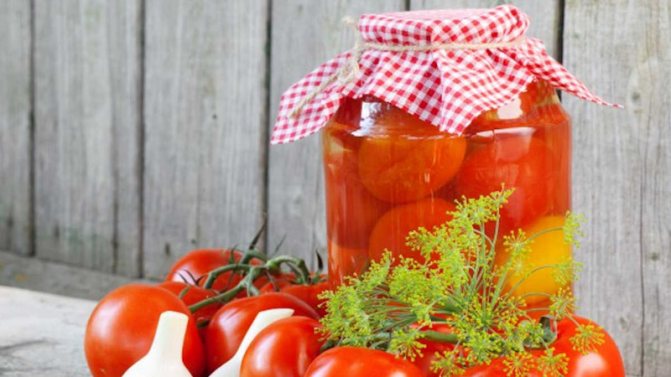

Advantages and disadvantages
A review of this section will summarize all the positive qualities of culture and point out some of the disadvantages. The benefits include:
- drought resistance;
- early ripening;
- amicable return:
- unpretentious care;
- does not require pinching;
- high rate of fruiting;
- the possibility of breeding in any region;
- immunity to disease;
- great fruit taste;
- universal purpose;
- long storage;
- long transportation.
The disadvantages include the obligatory garter of low-growing plants, but this is a common procedure with which all gardeners are familiar.
Farmers reviews


Judging by the characteristics and reviews of those who planted crops in their gardens, for most gardeners this tomato is a kind of magic wand that will not fail under any circumstances.
Vera, Magnitogorsk: “I was very impressed with the photos, so I decided to plant this tomato. The seeds sprouted together, the seedlings did not hurt. Grown in the open field. Even with minimal care, the variety pleased with its yield. 6-7 fruits ripened on each bush. Used for pickling, but they are good fresh too. I will definitely plant it again. "
Peter, Nizhny Novgorod: “Great view for open ground. I always plant low-growing tomatoes in the garden without shelter. The bushes do not stretch and give a good offspring. Vegetables of an unusual elongated shape. The pulp is juicy. The taste is pleasant, you can add these tomatoes to salads. The variety is also suitable for conservation. I didn’t pinch the plants, the yield was at the level ”.
Care
If the plant does not need pinching, then tying to the supports will be needed almost immediately after moving the seedlings into the ground.
The tomato requires abundant watering at the root. It is better to carry out them with warm, settled water up to 2 times a week in the evening to protect delicate stems and leaves from possible sunburn. It is worth increasing the amount of watering at the stage of fruit formation.
():
In the transition to the phase of mass fruiting, watering is reduced, watered with smaller volumes of water, so as not to reduce their quality.
The planting yield can be increased by applying fertilizers. For the first time, this can be done within 2 weeks after transferring the seedlings to the soil. For this period, carbamide, mullein or nitrogen fertilizers of a chemical nature are suitable. These dressings strengthen the bush, contribute to the rapid development of green mass.
During flowering and fruit setting, it is worth applying phosphorus-potassium fertilizers. They protect the plant from pests, promote high-quality ripening and maintain the overall health of the planting. Spraying is used against insects that feed on leaves and flowers, destroying bushes.
The description of cultivar care includes mandatory work with the soil.
- Loosening - at least once a week.
- Weed Removal - These plants remove nutrients and water, reducing overall yield.
- Covering with a film in case of planting in open ground to protect against changes in air and soil temperature.
If the tomato was planted in a greenhouse, additional care points are required. Greenhouses and greenhouses need to be regularly ventilated, otherwise the likelihood of developing fungal diseases is high, which can not only destroy the entire planting, but also make the soil unsuitable for growing for the next few years.
():
The optimum humidity for tomato is 45-60%, and the temperature is 22-27 degrees. When the temperature and humidity in the greenhouse rises, measures should be taken: ventilate the greenhouse by opening the transoms and vents; it is recommended to shade the greenhouse during hot times.
Tomato Valentine characteristics and description of the variety
This variety was bred several decades ago, but at the beginning of this century, breeders began to improve the Valentine's tomato, as a result, its yield and taste of the fruit sharply increased.
The bushes of this variety are dense and compact, their height can reach 0.55-0.65 m. Valentine's tomato belongs to the early maturing varieties - from the moment the first sprouts appear until the harvest ripens, it usually takes about 3.5 months.
Photo of a bag of tomato seeds Valentine


And those growers who grow this variety in greenhouse conditions say that stepchildren on seedlings should be removed in small quantities - then these tomatoes actively bear fruit throughout the season.
The bushes of this variety have a spreading shape, therefore, it is recommended to tie them up during the growth process so that the shoots do not break off under the weight of ripening fruits.
The shoots are weakly leafy, but this is not a sign that the plant has not been properly grown - this is just a feature of this variety. Another feature of Valentine's tomato is the color of the leaf plates - green with a yellowish tint. The foliage is slightly corrugated and looks more like potato leaf plates.
The first flowers appear at the level of 7-8 permanent leaves, then they are located after a couple of leaves up the stems. Usually flowers are collected in racemose inflorescences - up to 10-12 ovaries can form on one brush. The fruits of the first harvest are round and new ripening fruits are plum-shaped. In general, the fruits of this variety are small in size with a weight of about 85 g.
The pulp is very tasty, sweet and sour, slightly sugary, the skin is of medium density, not prone to cracking.
Tomato valentine photo


Tomato yield Valentine
Up to 3 kg of ripe fruits are harvested from each bush, which is considered a good yield. Up to 7 bushes are grown per 1 m2, from which about 11-13 kg of ripe tomatoes are harvested.
Tomato valentine videos
The resistance of Valentine's tomato to the main diseases inherent in tomatoes is above average. The variety is quite resistant to short-term drought. But gardeners should not flood the bushes of this variety if they have not been watered for a week and a half, otherwise this vegetable crop can be harmed.
Tomato Valentine is called a plant for lazy people, because it is not picky about soil fertility, does not require pinching and regular feeding.
Varietal characteristics
Tomato variety Valentine belongs to a group of early ripening plants, the fruits ripen on the 105th day.Vegetable growers recommend refusing to pinch bushes, for this variety, these manipulations are fraught with loss of yield.
Fruit
The shape of Valentine's tomatoes is plum-shaped, elongated to the edge. Fruits are medium in size, weighing up to 100 g.
Thanks to their dense pulp, tomatoes can be stored for a long period and are not damaged during transportation. The fruits are very juicy and fleshy and can be used for making juice, sauces or pasta.
Clusters with abundant fruit are formed on the bush. Ripening, they turn red, may have an orange tint. Against the background of others, this variety stands out due to the original sweet and sour taste of the pulp.
The composition contains vitamins of group B, C and K, fiber, carotene, organic sugars and acids, which makes these tomatoes not only tasty, but also healthy.
Bushes
The bush itself is low - it reaches only 60 cm in height. It has weak thin shoots and an abundant green mass. To keep the plant from getting damaged, it needs additional support and tying.
Leaves are medium in size and green in color. Demonstrates good growth performance in greenhouse planting and outdoors.
Agrotechnics of growing tomato Valentine
In the conditions of the Urals and Siberia, it is better to grow a Valentine tomato in greenhouses or greenhouses. Although the plant is adapted to these regions, it does not tolerate low temperatures during the formation of buds and ovaries, therefore, fruiting will deteriorate.
Seedlings should not be subjected to the picking procedure, because when the root system is injured, the seedlings then get sick for a long time, which negatively affects its further growth and fruiting. Therefore, it is better to plant Valentine tomato seeds immediately at the appropriate distance in the container.
During the period of seedling growth, it is necessary to water them well, and also take care of sufficient illumination of the seedlings.
Transplanting seedlings into open ground is carried out at the stage of 5-7 permanent leaves. The soil in the beds should be well heated and loose enough.
This plant is not demanding on the quality composition of the soil in which it grows.
But a nutrient substrate should be placed in the planting holes, which includes:
- sand;
- peat;
- rotted manure (taken in equal parts).
In the future, caring for Valentine's tomatoes consists in:
- regular watering (a little every two days);
- constant loosening of the soil;
- removing weeds;
- preventive treatments against insect pests;
- when grown in greenhouses, they should be regularly ventilated so that air humidity does not increase in them;
- after planting seedlings in open ground, for the first time, they must be covered with a film coating at night in order to protect them from possible frost.
Photo of tomatoes Valentine
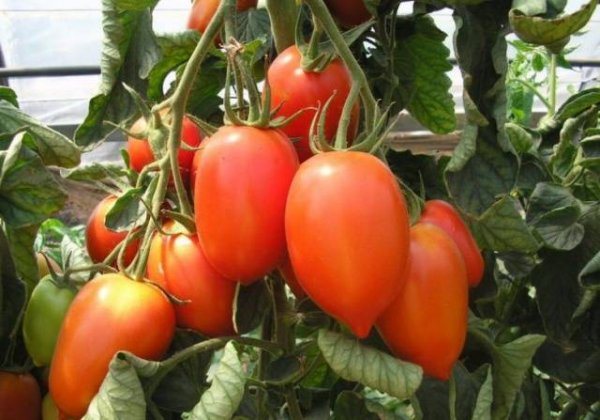

conclusions
- Valentine's tomatoes are characterized by early maturity and high yield - on average 3-4 kg per 1 bush.
- Not susceptible to disease if you follow the rules of care and watering
- Suitable for growing in greenhouses and outdoors. How to grow tomatoes outdoors is described in this material.
- A distinctive feature is long-term storage and the ability to transport over long distances. Often, due to these qualities, I choose a variety for growing for sale.
Tomato Valentine - benefits
Experts refer to the main positive qualities of Valentine's tomato:
- good yield;
- excellent taste of ripe fruits;
- high resistance to most diseases;
- pinching is not required;
- compact size of bushes;
- the harvested crop tolerates long-distance transportation;
- the variety tolerates a short drought well, is not picky about care.
Video:
There are practically no disadvantages of this vegetable plant. It should only be noted that the bushes must be tied up during the period of amicable ripening of the crop.
Thanks to its positive qualities, the Valentine tomato is perfect for those summer residents who have a little free time to care for vegetables in the beds - after all, even with a minimum investment of effort, this tomato gives good yields.
Did you grow a tomato of this variety? Leave Valentine's tomato reviews for other growers.
Tomato Valentine: description and characteristics from the manufacturer SeDeK
Early maturing (95-98 days) variety for open ground. The plant is determinate, semi-spreading, 60-70 cm high. It does not require compulsory pinching. Fruits are plum-shaped, red, weighing 80-120 g, thick-skinned, fleshy, with a high content of ascorbic acid. The value of the variety: resistance to drought, consistently friendly yield of the crop, excellent taste, resistance of fruits to cracking. Recommended for canning and pickling.
Tomato Valentine is a successful variety of domestic selection. It is distinguished by early ripening, unpretentiousness, presentation and good taste of the fruit. To obtain a high yield, they follow the planting and care scheme for the crop.
Description of Valentine's tomato
Tomato Valentine has been in the State Register since 1998. Its landing is allowed in any region of Russia. The variety is intended for open ground. It is recommended to grow it in garden plots and on farms.
Plant of determinant type, non-standard, spreading. The branching of shoots is weak, the number of leaves is below average. The height of the bush is 55-60 cm. The leaves are medium, slightly corrugated, typical for tomatoes, green-yellow in color, have stipules.
The inflorescences are simple. The first bud appears above the 7th leaf. The next inflorescences are laid every 1-2 leaves. The peduncle has an articulation. Fruiting begins 97 days after seed germination.
Description of fruits
Description and photo of Valentine's tomato:
- medium sizes;
- fleshy pulp;
- smooth thick skin;
- elongated oval shape;
- the color of unripe fruits is light green, becoming orange-red as it ripens;
- number of nests - 2 pcs.;
- weight from 80 to 87 g.
The taste qualities of Valentine's tomatoes are rated at a high level. Of the total harvest, 95-97% of tomatoes have commercial properties. Fruiting is not prolonged, all fruits ripen at the same time.
Characteristics of Valentine's tomato
Valentine's tomatoes stand out among other varieties for their characteristics. Gardeners especially appreciate productivity, versatility, and resistance to drought and disease.
Productivity and fruiting
The variety bears harvest in July-August. According to the description, Valentine's tomatoes give 12 kg of fruit per 1 sq. m landings. Up to 4 kg of tomatoes are heeded from one bush. Tomatoes are planted in open areas. Landing under a film cover is allowed. The yield is positively influenced by the intake of water and minerals.
Scope of the fruit
The Valentine's tomato has universal application. The fruits are eaten fresh for snacks and salads. Tomatoes are suitable for whole-fruit canning, they do not boil over when cooked.
Disease and pest resistance
The Valentina variety is resistant to major diseases. To protect the plantings from fungal diseases, they follow the rules of care and carry out preventive spraying. Insects are treated with insecticides or folk remedies.
Advantages and disadvantages of the variety
Valentine's tomato deserves attention due to the following characteristics:
- drought resistance;
- friendly ripening of fruits;
- the universal purpose of tomatoes;
- compact size;
- do not require pinning;
- early fruiting.
The relative disadvantage of the Valentine tomato is the need for care. Tomatoes need watering, feeding, tying.
Diseases and pests
Variety "Valentina" is resistant to most diseases.For preventive purposes, many gardeners, before planting, treat the beds with a solution of copper sulfate or water the area with hot potassium permanganate.
Plants can be harmed by such insects:
- Aphid;
- Thrips;
- Colorado beetles;
- Spider mites.
Traditional methods, biological methods and chemicals will help fight harmful insects.
IMPORTANT: Valentina tomatoes tolerate mild drought well.
Growing rules
For the successful cultivation of tomatoes, Valentine comply with a number of conditions: they prepare seeds for planting, take care of seedlings and adult plants. Although the variety is considered to be undemanding, taking good care of it will avoid disease and increase yields.
Planting seedlings
For planting seeds of the Valentine variety, wooden boxes or plastic containers are prepared. They are washed with warm water and soap. To avoid picking, it is convenient to use peat cups for seedlings. They take the soil from their site or buy special soil for tomatoes. The soil is prepared in late autumn, compost or humus must be added. For disinfection, the soil is heated in an oven or poured with a solution of potassium permanganate.
The soil is poured into the container, lightly tamped and watered. The seeds are deepened by 1 cm and left between them 1.5-2 cm. The next row is formed after 3 cm. The plantings are covered with foil and kept in a dark place. To accelerate the growth of tomatoes, maintain the temperature above + 24 ° C. Polyethylene is constantly turned over and condensation is removed from it. In such conditions, the first shoots appear in 7-10 days.
Containers with sprouts are transferred to the windowsill. Styrofoam is placed under them to protect the tomatoes from the cold. Seedlings of the Valentine variety provide a number of conditions:
- temperature regime during the day + 22-25 ° С, at night - about + 18 ° С;
- airing the room;
- moderate humidity;
- continuous lighting 14 hours a day.
The tomatoes are watered when the soil begins to dry out. Moisture is introduced using a spray bottle. Prevents stagnation of water in the soil. Seedlings of Valentine's tomatoes do not need feeding. If the plants do not have enough light, additional phytolamps are installed.
When the tomatoes have 2 leaves, they start picking. Valentine's tomatoes are seated in separate containers. The soil is used with the same composition as for the seeds. The strongest and most developed plants are selected. First moisten the soil, then carefully remove the tomatoes from the boxes. The seedlings are transferred to the holes, their roots are covered with earth and watered.
Transfer
Tomatoes are prepared for transplantation at the age of 35-40 days. Usually, work is carried out in May or early June. Waiting for the soil to warm up and warm weather. If the probability of frost remains, then at first the tomatoes are covered with agrofibre.
The beds for tomatoes are prepared in the fall: they are dug up and fertilized with humus. The culture grows well in sunny areas with fertile light soil. It is best to choose an area for planting where cabbage, carrots, beets, onions, garlic or herbs grew a year earlier. It is not recommended to plant tomatoes immediately after potatoes, peppers, eggplants.
If it is not possible to equip new beds, then the top layer of earth 30-40 cm thick is completely changed.
Valentine tomatoes are planted on a warm, cloudy day. For plants, holes are prepared with a depth of 15-20 cm. 40-50 cm are left between the tomatoes, 60 cm between the rows. m place no more than 4 plants. The seedlings are transferred together with a clod of earth or a peat tablet. After planting, tomatoes are not watered or fed for 2-3 weeks.
Follow-up care
Valentine's tomatoes are provided with moderate watering. Before flowering, moisture is applied every week in an amount of 4-5 liters. When forming buds, tomatoes are watered every 3 days, the water consumption is reduced to 3 liters. In order for moisture to be absorbed faster, be sure to loosen the soil. In this case, it is important not to damage the roots of the tomatoes. Mulching will help to reduce the number of waterings.A layer of straw or humus is poured onto the beds.
Valentine tomatoes are fed for 2-3 weeks. Before flowering, slurry or urea solution is applied. The fertilizer contains nitrogen, which activates the active growth of shoots. During flowering and fruit formation, phosphorus-potassium dressings are introduced. For 10 liters of water add 35 g of superphosphate and potassium salt. Tomatoes are watered with a solution under the root.
Although the Valentine variety is undersized, it is tied to supports. So the bushes lean to the ground, and the fruits do not come into contact with wet soil. A wooden bar or metal bar is used as a support.
Growing seedlings
It turns out that Valentine tomato seedlings can be grown without using land. Toilet paper and plastic film are what you need for seed germination. This method is convenient because:
- seedlings do not take up much space;
- a strong root system will appear;
- the fruiting of tomatoes will begin a week earlier;
- black leg disease will not appear.
Strips are made of polyethylene bags, the width of which is equal to the width of toilet paper. A strip of toilet paper is placed on a strip of polyethylene and sprayed with water from a spray bottle. Having retreated from the edge of the strip by about a centimeter, spread the tomato seeds with an interval of three centimeters. The seeds are covered with another layer of toilet paper moistened with water, and a layer of polyethylene is placed on top. Do not twist it tightly and put it in a glass, the edge with the seeds should be at the top. A little water is poured into a glass.
The moisture on the toilet paper will wet the seeds, the film will create a greenhouse effect. You can cover the top of the glass with a plastic bag so that the paper does not dry out. Shoots will appear in a week, and after 14 days, shoots with two leaves can be planted in the ground. Further, the seedlings are looked after in the usual way.
Pest and disease control
The most dangerous diseases for tomatoes are fusarium, late blight, gray rot. The risk of spreading disease increases with cold weather and frequent rains. To protect the tomatoes of the Valentina variety, spraying with fungicides Fitosporin, Horus, Hom is performed. The preparations contain copper and inhibit the development of the fungus. Instead of chemicals, an infusion of wormwood, wood ash, and onion husks is used. Insecticides Spark, Actellik, Karbofos are effective against insects. Good prevention is adherence to agricultural practices. This includes rationing of irrigation, loosening the soil, weeding, moderate fertilizing with nitrogen substances.


